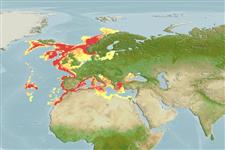分類 / Names
共通名の | 類義語 | Catalog of Fishes(部類, 種) | ITIS | CoL | WoRMS | Cloffa
全頭亜鋼 (chimaeras) >
Chimaeriformes (Chimaeras) >
Chimaeridae (Shortnose chimaeras or ratfishes)
Etymology: Chimaera: Named for the mythological creature composed of parts of multiple animals, referring to their odd mix of characteristics. (See ETYFish); monstrosa: Latin for strange or grotesque, referring to its strange appearance, as if composed of parts of multiple animals. (See ETYFish).
More on author: Linnaeus.
Environment: milieu / climate zone / depth range / distribution range
生態学
海 深海魚; 海洋回遊性 (Ref. 51243); 深さの範囲 40 - 1400 m (Ref. 104125), usually 300 - 500 m (Ref. 4443). Deep-water; 75°N - 27°N, 32°W - 35°E
Eastern Atlantic: northern Norway and Iceland, Skagerrak and Kattegat south to Morocco including western Mediterranean (some isolated records from eastern part), Azores and Madeira Islands. Records from South Africa are questionable. Reported from Oshima, Japan (FMNH 89161) (Ref. 27954).
Length at first maturity / サイズ / 重さ / 年齢
Maturity: Lm 45.9 range ? - ? cm
Max length : 150 cm TL オス/雌雄の選別がない; (Ref. 35388); 最大公表体重: 2.5 kg (Ref. 4645)
Bathydemersal to benthopelagic generally between 300 and 500 m depth. Found in the upper continental slope. Usually found in deeper waters in southern latitudes, while making a summer inshore migration up to 40-100 m in the northern areas. Sluggish, usually occurring in small groups. Feeds mainly on bottom-living invertebrates. The single dorsal spine is sharp and pointed, and although only mildly venomous can inflict a painful wound. Oviparous. Males have a clasper on the forehead that is probably used to hold on to the female during copulation. Egg capsules are about 17 cm long; young look alike adults and hatch when 10 cm long. Common by-catch when trawling for shrimps in the North Sea or Skaggerak.
Life cycle and mating behavior
Maturities | 繁殖 | Spawnings | Egg(s) | Fecundities | 幼生
Oviparous; egg-capsules slender, club-shaped with narrow lateral membranes and a horny filament at the long pointed end, 17 cm long and 3 cm wide; deposited mainly in spring and summer. The embryos developing in about 9-12 months and hatch at 10 cm length.
Krefft, G., 1990. Chimaeridae. p. 111-113. In J.C. Quero, J.C. Hureau, C. Karrer, A. Post and L. Saldanha (eds.) Check-list of the fishes of the eastern tropical Atlantic (CLOFETA). JNICT, Lisbon; SEI, Paris; and UNESCO, Paris. Vol. 1. (Ref. 4443)
人間に対する脅威
Traumatogenic (Ref. 4690)
Human uses
水産業: 少数商業の
用具
特記事項
XMLをダウンロードして下さい
インターネットの情報源
Estimates based on models
Preferred temperature (Ref.
123201): 3.7 - 14.1, mean 7.9 °C (based on 179 cells).
Phylogenetic diversity index (Ref.
82804): PD
50 = 0.5000 [Uniqueness, from 0.5 = low to 2.0 = high].
Bayesian length-weight: a=0.00135 (0.00073 - 0.00248), b=3.05 (2.88 - 3.22), in cm total length, based on LWR estimates for this species & (Sub)family-body (Ref.
93245).
栄養段階 (Ref.
69278): 3.5 ±0.0 se; based on diet studies.
Generation time: 16.4 ( na - na) years. Estimated as median ln(3)/K based on 2
growth studies.
回復力 (Ref.
120179): 低い, 4.5年~14年の倍増期間の最小個体群 (Assuming Fec <100;).
Fishing Vulnerability (Ref.
59153): High to very high vulnerability (68 of 100).
Climate Vulnerability (Ref.
125649): Moderate vulnerability (38 of 100).
Nutrients (Ref.
124155): Calcium = 7.33 [2.04, 25.54] mg/100g; Iron = 0.33 [0.11, 0.85] mg/100g; Protein = 14.7 [9.9, 18.5] %; Omega3 = 0.239 [0.093, 0.622] g/100g; Selenium = 22 [6, 73] μg/100g; VitaminA = 5.79 [1.22, 27.56] μg/100g; Zinc = 0.326 [0.169, 0.636] mg/100g (wet weight);
